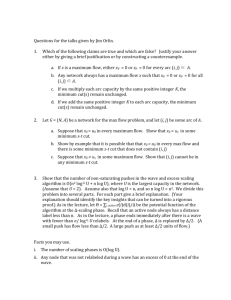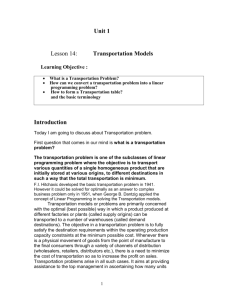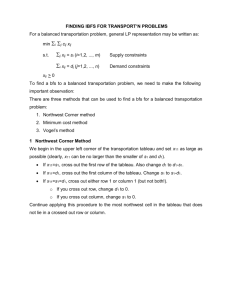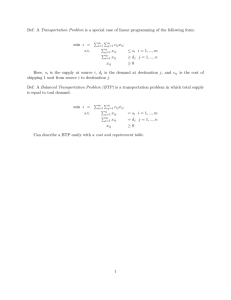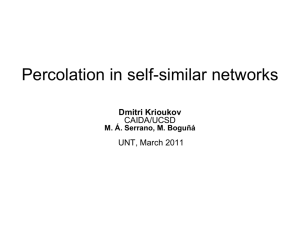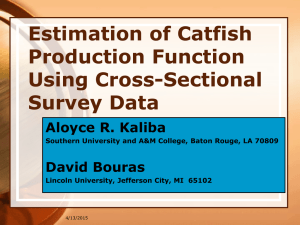MARCINKIEWICZ-TYPE STRONG LAW OF LARGE NUMBERS RANDOM VARIABLES
advertisement
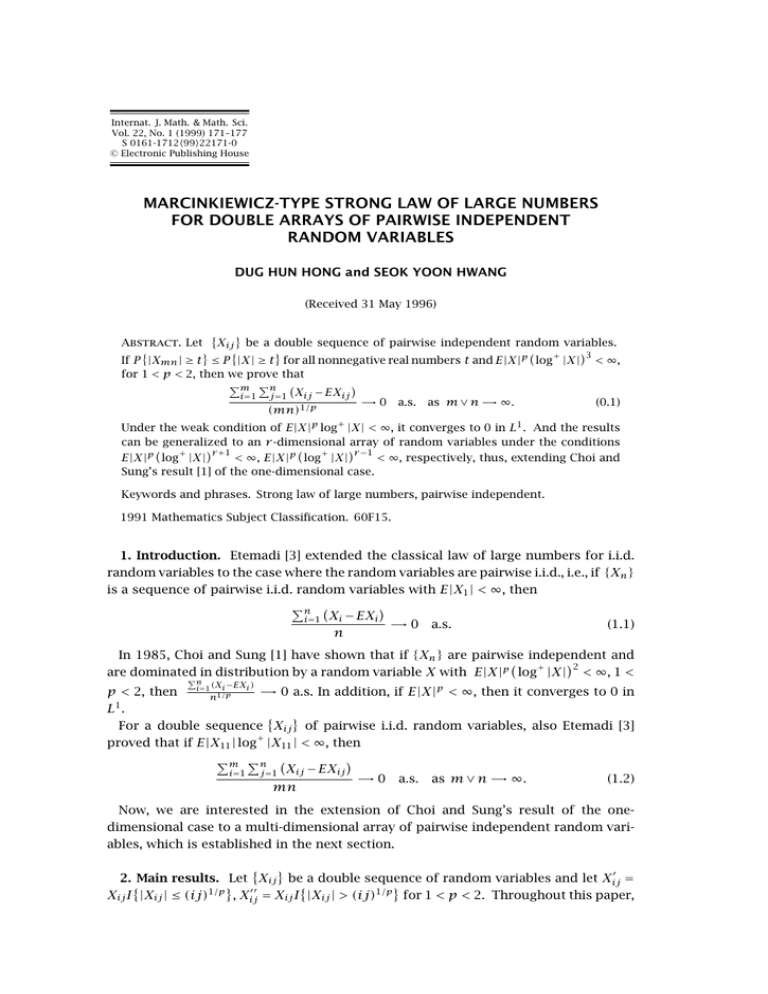
Internat. J. Math. & Math. Sci.
Vol. 22, No. 1 (1999) 171–177
S 0161-17129922171-0
© Electronic Publishing House
MARCINKIEWICZ-TYPE STRONG LAW OF LARGE NUMBERS
FOR DOUBLE ARRAYS OF PAIRWISE INDEPENDENT
RANDOM VARIABLES
DUG HUN HONG and SEOK YOON HWANG
(Received 31 May 1996)
Abstract. Let Xij be a double sequence of pairwise independent random variables.
3
If P |Xmn | ≥ t ≤ P |X| ≥ t for all nonnegative real numbers t and E|X|p log+ |X| < ∞,
for 1 < p < 2, then we prove that
m n i=1 j=1 Xij − EXij
→ 0 a.s. as m ∨ n → ∞.
(0.1)
(mn)1/p
Under the weak condition of E|X|p log+ |X| < ∞, it converges to 0 in L1 . And the results
can be generalized to an r -dimensional array of random variables under the conditions
r +1
r −1
< ∞, E|X|p log+ |X|
< ∞, respectively, thus, extending Choi and
E|X|p log+ |X|
Sung’s result [1] of the one-dimensional case.
Keywords and phrases. Strong law of large numbers, pairwise independent.
1991 Mathematics Subject Classification. 60F15.
1. Introduction. Etemadi [3] extended the classical law of large numbers for i.i.d.
random variables to the case where the random variables are pairwise i.i.d., i.e., if {Xn }
is a sequence of pairwise i.i.d. random variables with E|X1 | < ∞, then
n i=1 Xi − EXi
→ 0 a.s.
(1.1)
n
In 1985, Choi and Sung [1] have shown that if {Xn } are pairwise independent and
2
are dominated
in distribution by a random variable X with E|X|p log+ |X| < ∞, 1 <
n
(X −EX )
i
i
→ 0 a.s. In addition, if E|X|p < ∞, then it converges to 0 in
p < 2, then i=1n1/p
1
L .
For a double sequence Xij of pairwise i.i.d. random variables, also Etemadi [3]
+
proved that if E|X11 | log |X11 | < ∞, then
m n i=1
j=1 Xij − EXij
→ 0 a.s. as m ∨ n → ∞.
(1.2)
mn
Now, we are interested in the extension of Choi and Sung’s result of the onedimensional case to a multi-dimensional array of pairwise independent random variables, which is established in the next section.
2. Main results. Let Xij be a double sequence of random variables and let Xij
=
Xij I |Xij | ≤ (ij)1/p , Xij = Xij I |Xij | > (ij)1/p for 1 < p < 2. Throughout this paper,
172
DUG HUN HONG AND SEOK YOON HWANG
c denotes an unimportant positive constant which is allowed to change and dk the
number of all divisors of integer k.
To prove the main theorem, we need the following lemmas.
Lemma 2.1. Let Xij be a double sequence of pairwise independent random vari
ables. If P |Xmn | ≥ t ≤ P |X| ≥ t for all nonnegative real numbers t, then
2
∞
∞ E Xij
(a)
(ij)2/p
i=1 j=1
∞
∞ E Xij
(b)
i=1 j=1
(ij)1/p
≤ cE|X|p log+ |X|,
(2.1)
p
+
≤ cE|X| log |X|
for 1 < p < 2.
2
| is given by
Proof. The estimation of E|Xij
2
≤
E Xij
≤
(ij)2/p
0
(ij)2/p
0
2
P Xij ≥ t dt
P |X|2 ≥ t dt
(2.2)
(ij)2/p =
P t ≤ |X|2 < (ij)2/p + P (ij)2/p ≤ |X|2 dt
0
=
(ij)1/p
0
x 2 dF (x) + (ij)2/p P (ij)2/p ≤ |X|2 ,
∞
2/p
k=i+1 dk /k
where F (x) is the distribution of X. If we use the fact that
(i + 1)2/p−1 , we obtain
∞
∞ 1
2/p
(ij)
i=1 j=1
(ij)1/p
0
= O log i/
1/p
∞
dk k
x 2 dF (x)
k2/p 0
k=1
1/p
∞
∞
dk (i+1)
x 2 dF (x)
≤c
2/p
k
i1/p
i=0 k=i+1
x 2 dF (x) ≤ c
≤c
∞
log i
(i
+
1)2/p−1
i=0
(i+1)1/p
i1/p
(2.3)
x 2 dF (x)
≤ cE|X|p log+ |X| < ∞.
And
∞
∞ ∞
P (ij)2/p ≤ |X|2 =
dk P k ≤ |X|p
i=1 j=1
k=1
=
∞
k=1
=c
∞
k
dj P k ≤ |X|p < k + 1
j=1
k log kP k ≤ |X|p < k + 1
k=1
≤ cE|X|p log+ |X| < ∞,
(2.4)
MARCINKIEWICZ-TYPE STRONG LAW OF LARGE NUMBERS . . .
where we use the fact that
n
k=1 dk
= O(n log n). It follows that
2
∞
∞ E Xij
i=1 j=1
By the fact that
method.
n
(ij)2/p
1/p
k=1 dk /k
173
< ∞,
which proves (a).
(2.5)
= O n1−(1/p) log n , we can obtain (b) by the same
The following lemma is a two parameter analog of [5, Lem. 3.6.1a].
Lemma 2.2. Let Xij be a double sequence of pairwise independent random varim n
ables with EXij = 0, and let Smn = i=1 j=1 Xij . Then
2
n
m 2
E Xkl .
E max Sij ≤ c(log m)2 (log n)2
1≤i≤m
1≤j≤n
(2.6)
k=1 l=1
Proof. For m = 1 and n = 1, the inequality is trivial. If m > 1, let s be an integer
such that 2s−1 < m ≤ 2s . And if n > 1, let t be an integer such that 2t−1 < n ≤ 2t . We
can assume that m, n > 1. We assign Xij to the point (i, j) of integer in (0, 2s ]×(0, 2t ]
(if m < i ≤ 2s or n < j ≤ 2t , set Xij = 0). Divide the interval (0, 2s ] into (0, 2s−1 ] and
(2s−1 , 2s ], each of these two intervals into two halves, and so on. Then the elements
of the ith partition are of length 2s−i , i = 0, . . . , s. Also, divide the interval (0, 2t ] in
the same way. Then we obtain the (i, j)th partition Pij of (0, 2s ] × (0, 2t ] by the ith
partition of (0, 2s ] and the jth partition of (0, 2t ]. Every rectangle (0, i] × (0, j] is
the sum of at most (s + 1)(t + 1) disjoint subrectangles each of which belongs to a
s t
different partition. We can write Sij = k=0 l=0 Ykl;ij , where Ykl;ij is the sum of all
r.v.’s belonging to the rectangle (a, b] × (c, d], b − a = 2k and d − c = 2l , which may
or may not be a summand of (0, i] × (0, j] so that some Ykl;ij may vanish. Let Tij =
2i 2j
2
k=1
l=1 |Ykl | , where Ykl is the sum of all r.v.’s which belong to the (k, l)-element of
s t
Pij . If we put T = i=0 j=0 Tij , by the elementary Schwarz inequality, we obtain
t
s 2
Ykl;ij 2 ≤ (s + 1)(t + 1)T .
Sij ≤ (s + 1)(t + 1)
(2.7)
k=0 l=0
Since ETij ≤
Xkl 2 , ET ≤ (s + 1)(t + 1) m n E Xkl 2 . It follows that
k=1
l=1
n
m 2
2
E max Sij ≤ (s + 1)2 (t + 1)2
E Xkl m n
k=1
l=1 E
1≤i≤m
1≤j≤n
k=1 l=1
n
m 2
≤ c(log m)2 (log n)2
E Xkl .
k=1 l=1
(2.8)
Theorem 2.3. Let Xij be a double sequence of pairwise independent random vari
ables. If P |Xmn | ≥ t ≤ P |X| ≥ t for all nonnegative real numbers t and E|X|p log+
3
|X| < ∞, for 1 < p < 2, then
m n i=1
j=1 Xij − EXij
lim
= 0 a.s.
(2.9)
m∨n →∞
(mn)1/p
174
DUG HUN HONG AND SEOK YOON HWANG
Proof. We denote by Smn =
the inequalities
m n
j=1 Xij ,
i=1
Smn
=
m n
j=1 Xij .
i=1
Then we obtain
∞
∞ ∞
P Xij = Xij
dk P |X11 | > k1/p
=
i=1 j=1
k=1
≤
∞
dk P |X| > k1/p
k=1
=
∞
i=1
≤c
i
dk
k=1
∞
i log i
(i+1)1/p
(i+1)1/p
i1/p
i=1
dF (x)
i1/p
(2.10)
dF (x)
≤ cE|X|p log+ |X| < ∞,
Hence, by the Borel-Cantelli lemma,
m n
i=1
j=1
Xij − Xij
(mn)1/p
→ 0
a.s.
(2.11)
Now, we use Chebyshev’s inequality and Lemma 2.1 to obtain
∞
∞ S k l − ES k l Var S2 k 2l
2 2
2 2 P >
"
≤
c
2k 2l 1/p k l 2/p
k=1 l=1
k=1 l=1 2 2
∞
∞ =c
∞
∞ 2k 2l
k=1 l=1
≤c
1
k
2/p
l
2
2 i=1 j=1
Var Xij
(2.12)
2
∞
∞ EXij
i=1 j=1
(ij)2/p
≤ cE|X|p log+ |X|p < ∞,
which follows easily by summation by parts. It follows that
S2 k 2l − ES2 k 2l
→ 0
1/p
2k 2 l
a.s.
(2.13)
And let
S ∗k l
∗
Smn
2 2
−
Tkl = max 1/p
1/p k
l
k
k+1
(mn)
2 ≤m<2
2 2
≤
2l ≤n<2l+1
∗ S
2 k 2l
1/p
k l
2 2
∗ S mn
+ max
1/p
2k ≤m<2k+1 (mn)
2l ≤n<2l+1
∗
= Smn
− ESmn
.
where Smn
By using Lemma 2.2, we obtain, for any " > 0,
(2.14)
,
175
MARCINKIEWICZ-TYPE STRONG LAW OF LARGE NUMBERS . . .
∞
∞
P
k=0 l=0
max
∞
∞ "
≤c
≥
2
mn
2k ≤m≤2k+1
2l ≤n≤2l+1
∗ S (mn)1/p
2
∗
1
max Smn
2/p E
2k ≤m≤2k+1
2k 2l
k=0 l=0
2l ≤n≤2l+1
k+1 l+1
≤c
∞
2
2
∞ (k + 1)2 (l + 1)2 2
E Xij
2/p
k+1
l+1
2 2
k=0 l=0
i=1 j=1
≤c
∞
∞ (log2 ij)2 2
E Xij
,
2/p
(ij)
i=1 j=1
(2.15)
where the last inequality follows easily be summation by parts. But
1/p
∞
∞ ∞
(log2 ij)2 dk (log2 k)2 k
X 2 ≤
E
x 2 dF (x)
ij
2/p
2/p
(ij)
k
0
i=1 j=1
k=1
1/p
∞
∞
dk (log2 k)2 (i+1)
x 2 dF (x)
≤
k2/p
i1/p
i=0 k=i+1
∞
≤c
i1−(2/p) (log i)3
(i+1)1/p
i1/p
i=0
(2.16)
x 2 dF (x)
3
≤ cE|X|p log+ |X|p < ∞,
∞ dk (log2 k)2
(log i)3
= O i(2/p)−1 which follows by summation by parts.
where we use
k=1
k2/p
Hence, (2.13), (2.15), and (2.16) give us
Smn
− ESmn
→ 0
(mn)1/p
a.s.
(2.17)
a.s.
(2.18)
Combining (2.11) and (2.17), we get
Smn − ESmn
→ 0
1/p
(mn)
Since
Smn − ESmn
Smn − ESmn
=
−
(mn)1/p
(mn)1/p
m n
i=1
j=1 E
X (mn)1/p
ij
,
(2.19)
it remains to prove that the second term of the right-hand side converges to 0 a.s. By
Lemma 2.1(b), we obtain
∞
∞ 2k 2l
k=1 l=1
i=1
∞
E Xij
j=1 E Xij
1/p
k l
2 2
≤c
i,j=1
(ij)1/p
p
(2.20)
+
≤ cE|X| log |x| < ∞,
from which, it follows that
2k 2l
lim
k∨l →∞
i=1
j=1 E Xij
1/p
k l
2 2
= 0.
(2.21)
176
But since
DUG HUN HONG AND SEOK YOON HWANG
2k 2l
m n
X i=1 j=1 E X E
i=1
j=1
ij
ij Tkl = max −
1/p
(mn)1/p
2k ≤m≤2k+1 2k 2l
l
l+1
2 ≤n≤2
c
≤
2k+1 2l+1
1/p
k+1 2l+1
2
(2.22)
E X ,
i=1 j=1
ij
Tkl
converges to 0 which implies that, by (2.21),
m n
i=1
j=1 E Xij
(mn)1/p
→ 0.
(2.23)
This completes the proof.
Corollary 2.4. Let Xij be a double sequence of pairwise i.i.d. random variables
3
with E|X11 |p log+ |X11 | < ∞, for 1 < p < 2. Then
m n i=1
j=1 Xij − EXij
= 0 a.s.
(2.24)
lim
m∨n →∞
(mn)1/p
Remark. The generalization to r -dimensional arrays of random variables can be
r +1
< ∞.
obtained easily under the condition E|X|p log+ |X|
Theorem 2.5. Let Xij be a double sequence of pairwise independent random vari
ables. If P |Xij | ≥ t ≤ P |X| ≥ t for all nonnegative real numbers t and E|X|p log+
|X| < ∞, 1 < p < 2, then
m n i=1
j=1 Xij − EXij
→ 0 in L1 as m ∨ n → ∞.
(2.25)
(mn)1/p
Proof. Since Xij are pairwise independent, Xij
− EXij
are orthogonal which
implies that
2
m n
m n i=1 j=1 X − EX 2
i=1
j=1 E Xij
ij
ij ≤
.
(2.26)
E
(mn)1/p
(mn)2/p
Since
m n m n i=1 j=1 X − EX ij
ij i=1 j=1 Xij − EXij E
≤
E
(mn)1/p
(mn)1/p
(2.27)
m n
i=1
j=1 E Xij
+2
,
(mn)1/p
m n
2
2/p
converges to 0 as m ∨ n → 0.
it suffices to show that
i=1
j=1 E|Xij | /(mn)
But this can be shown by a method similar to that used in the proof of (2.23) in
Theorem 2.3.
Corollary 2.6. Let Xij be a double sequence of pairwise i.i.d. random variable
with E|X11 |p log+ |X11 | < ∞, for 1 < p < 2. Then
m n i=1
j=1 Xij − EXij
→ 0 in L1 as m ∨ n → ∞.
(2.28)
(mn)1/p
MARCINKIEWICZ-TYPE STRONG LAW OF LARGE NUMBERS . . .
177
Remark. The generalization to r -dimensional arrays of random variables can be
r +1
< ∞.
obtained under the condition E|X|p log+ |X|
Acknowledgement. This research was supported by the Catholic University of
Taegu-Hyosung.
References
[1]
[2]
[3]
[4]
[5]
[6]
[7]
B. D. Choi and S. H. Sung, On convergence of (Sn − ESn )/n1/r , 1 < r < 2, for pairwise
independent random variables, Bull. Korean Math. Soc. 22 (1985), no. 2, 79–82.
MR 87f:60044. Zbl 585.60043.
K. L. Chung, A course in probability theory, second ed., Probability and Mathematical Statistics, vol. 21, Academic Press, New York, 1974. MR 49 11579. Zbl 345.60003.
N. Etemadi, An elementary proof of the strong law of large numbers, Z. Wahrsch. Verw.
Gebiete 55 (1981), no. 1, 119–122. MR 82b:60027. Zbl 448.60024.
G. H. Hardy and E. M. Wright, An introduction to the theory of numbers, fourth ed., Clarendon Press, Oxford, 1960. Zbl 086.25803.
M. Loeve, Probability theory. I, fourth ed., Graduate Texts in Mathematics, vol. 45, SpringerVerlag, New York, 1977. MR 58 31324a. Zbl 359.60001.
R. T. Smythe, Strong laws of large numbers for r -dimensional arrays of random variables,
Ann. Probability 1 (1973), no. 1, 164–170. MR 49 11602. Zbl 258.60026.
W. F. Stout, Almost sure convergence, Probability and Mathematical Statistics, vol. 24, Academic Press, New York, 1974. MR 56 13334. Zbl 321.60022.
Hong: School of Mechanical and Automotive Engineering, Catholic University of
Taegu-Hyosung, Kyungbuk 712-702, South Korea
Hwang: Department of Mathematics, Taegu University, Kyungbuk 713-714, South Korea
